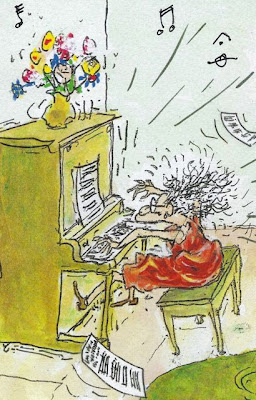The last time Gretna Music brought a countertenor to Lancaster was in the late 1980's. When Michael Dash, a giant African-American who had sung several roles at the Metropolitan Opera, sang the first note of Händel's "Furibundo," I deliberately watched the collective jaw-drop of all 425 listeners in St. James Church, who minutes later sprang to their feet to cheer. Equally astonished were staid native Lancastrians passing him on the street: they must have assumed the Eagles were scrimmaging in the provinces. "Furibundo," a Spanish word loosely meaning "raging maniac," was about the last sound you would expect to come from the lips of a fullback in a soprano voice.
Your next question is probably "so what is a countertenor and why do they exist?" I'll tell you that and then address another question that bothered me: Why did Händel cast a countertenor in a heroic male role, a King no less, such as the one Andreas Scholl sang last year at the Met in Rodelinda with Renée Fleming? Or for that matter also in the role of Julius Caesar?
The answer to your question has to do with the historic Roman Catholic Church (what doesn't? see "Threats to Music" Oct 20) and barbers. In the 16th century the Pope banned female singers in church and on the stage. For composers that was like having to write for a choir without soprano or alto sections. Popes and Cardinals, of course, continued to commission music requiring high voices and it was the Italians who had the greatest need for them in their operas (think Monteverdi, etc, and Handel, who spent 6 formative years in Italy).
Fortunately (in one sense) Italians were crafty enough to figure out a solution. They learned that if a boy was castrated (barber-"surgeons" usually did it) between the ages of 8 and 13, their pre-pubertal high voice would remain for the rest of their lives. As an added benefit, without a pubertal testosterone surge their bony epiphyses (bone joints) would remain open longer and their arms, legs and ribs would attain greater length. With larger chest cavities breath control could be developed beyond that of an average female singer and their voices become more powerful--even while their vocal apparatus remained that of a young boy.
It is estimated that over three centuries as many as 4,000 Italian boys a year were subjected to the snip (some probably encouraged by "stage parents"). Of course, most never developed into great musicians. Some who succeeded after intensive training, however, became the first rock stars of the modern music world, not only in the sense of musical prowess but also by attaining great wealth and celebrity and in becoming sex objects exactly as rock stars are now (but with no-risk guarantees for "bored wives" -- Norman Lebrecht). (See "The Castrato and his Wife" by Helen Berry; and know that castration does not always preclude erection.) Despite Popes and Cardinals outlawing the practice (that they created), making castrati peaked in the 18th century and finally ended only after the turn of the last century. Recordings of Alessandro Moreschi, the "Angel of Rome," document the last gasp of the barbaric tradition. By then women were allowed to sing in public, even by Popes.
Though castrati (and barber/surgeons) do not live on, the music that Händel and eventually English as well as Italian composers wrote for them does. An astonishing amount continues to be discovered and brought to life like gold from a newly-discovered mine, especially during an ongoing early music boom that began during the latter half of the 20th century. The much smaller boom of countertenoring, starting with Alfred Deller, follows, I presume, the desire to perform this music in a way close to the way it was originally intended. (We now speak of HIP, "historically-informed performance" to distinguish it from the discredited "authentic," too often a refuge for less capable playing on "primitive" instruments.)
A countertenor is thus a male singer who naturally would sing in the tenor or baritone range, but who has cultivated his falsetto range by "vibrating only the ligamentous edges of the vocal folds while leaving each fold's body relatively relaxed." Women can do the same, but listeners are less likely to notice the transition into falsetto high in their higher range. The falsetto range, less adorned by harmonics--higher frequency waves superimposed on the fundamental pitch--sounds more pure, as does a flute compared to an oboe or violin. Just about any adult can employ a falsetto.
Regarding my question about why Handel cast a countertenor in the role of Bertrarido, hero and King in Rodelinda, practicality may be the best answer. After moving to London in 1713, becoming a naturalized British subject in 1727, and achieving fame as a composer of Italian operas, Handel hired Francesco Bernardi Senesino (1686 – 1758), a celebrated Italian contralto castrato as a lead male singer in his company, the Royal Academy of Music, for a handsome salary. Senesino remained in London for much of the succeeding sixteen years, became a friend and associate of many in the highest levels of society, and created seventeen leading roles for Handel including Giulio Cesare, Orlando, and Bertarido in Rodelinda. Composer and singer never got along well and eventually had a tumultuous falling out.
By then public interest in Italian operas was waning and Handel turned to oratorio, Messiah (1741) his sixth, almost instantly establishing his position for posterity. Over its millions of performances the voicing and instrumentation of Messiah has varied tremendously, including occasional singing of the alto part by a countertenor. Perhaps to get back at the Popes, parts written for countertenors, like Giulio Cesare, are now sometimes sung by women! ("pants" roles)
Wednesday, December 5, 8:00 PM
Steinman Hall, Ware Center, Lancaster,
Steinman Hall, Ware Center, Lancaster,

